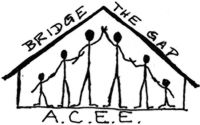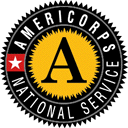HANDBOOK CONTENTS:
Working with Volunteers / Mentors
Coordinating After School Clubs & Activities
ACEE Home Page
Corporation for National Service: AmeriCorps

There are eight sessions in the curriculum. One of the goals is to have the kids develop their own 'peace game'. Once they have developed their own game, all the classrooms will get together and have a Piece by Peace Festival. Each class plays each others' game and at the end meet with their teacher and volunteers to talk about each game. Whether the game they played was a peace game. What made it a peace game? What did you like or dislike? How would you have made it better? The binder with curriculum for Pre-K through 6th grade is with the other VISTA materials at Sanchez, or with Bryan. Mrs. Krebs at Sanchez is the contact for more information. Jennifer San Pedro (VISTA 1999-2000) notes that: "We worked together to help teachers present this curriculum to the intercession students over the summer. That went over well after being introduced to it. The participating teachers were: Ms. Cook, Mrs. Krebs, Mr. Wahrer, Ms. Gamboa, Ms. Tammy Smith, Mrs. Mireles, Mrs. Zuniga, Ms. Rolls and Ms. Betty Castro. You might want to talk to them and get more feed back as well. Mrs. Krebs and I talked about doing this program and how to get it up and running. We had two ideas: 1) Do an after-school club based on the curriculum. Mrs. Krebs said she would not mind being in charge, but wanted AmeriCorps to help. So talk to her for more details 2) Make it a volunteer program every Friday for an hour. (I prefer this one)" How to Make Piece By Peace into a Volunteer Program: First, get familiar with the curriculum. Look through the manual towards the end you will find something that says "Unit One: Introduction to Peace Games & Conflict" start here. Each unit is a lesson and each lesson should take at most 40 -45 minutes. Find at least three volunteers for each classroom. Jennifer suggests starting with the 5th or 6th graders and to begin with just one or two classes, depending on the number of volunteers. Jennifer says, "Last year, Friday from 1 - 2 p.m. worked well for both grades, so just set up a meeting time with all 5th and 6th grade teachers, and tell them your plans, ask for suggestions and invite them to participate as well." Potential volunteers must go through a formal orientation about volunteering at Sanchez (see other section), when they will complete an application and submit information for a background check. These Peace Game volunteers will also need special training to help with this program. Talk to Mrs. Krebs about how this should happen. Each Peace Games volunteer gets a training manual. If you talk to the Vice Principal, Mrs. Krebs or Bryan ahead of time, they may be able to provide you with the materials needed. Go through the list of materials in the VISTA binders first and find out how much of what you need is there, and what additional information you need. At the orientation and again at the Peace Games training (if the two happen on different dates), the rules of Piece by Peace should be explained. It should also be emphasized that the commitment is for eight to nine weeks, one hour a week, and that each person is responsible for their other teammates and making sure they have planned ahead. Then the volunteers will break up into groups of three. Each group of three will be working together throughout the eight weeks. Give the new groups an opportunity to practice the first session of the curriculum. Again, talk to Mrs. Krebs about how this should happen. Finally, have the volunteers talk about the Piece by Peace Games Festival. By the eighth lesson, the kids should be making up their own conflict resolution game, with absolutely no help from the volunteers except guidance. Once everyone has finish their game, set up a day to have all the classes set up their game and play the other classes' games. Once you regroup at the festival, ask and discuss whether or not each game played was a peace game. What made it a peace game? What did participants like or dislike? How do different students suggest to make it better? Jennifer also says, "Of course there are some details missing so if you have specific questions PLEASE call or e-mail me. When I have time, I will try to make a more specific training manual."
Peace Games in other cities:
Other organizations promoting non-violence: |

